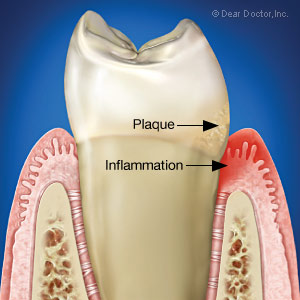Warning Signs of Periodontal (Gum) Disease
Don't wait until it's too late
Dear Doctor,
I'm scared of losing my teeth like both my parents because of gum disease especially because they never seemed to be in any pain. Even though I always see my dentist regularly, am I at risk for gum disease and what should I look for?
Dear Nancy,
This is an important question; generally speaking periodontal (gum) diseases (peri-around, odont-tooth) are chronic diseases and sometimes described as silent — silent in the sense that they don't cause any symptoms that might be readily associated with disease or a problem.
 |
| Figure 1: Gum tissues bleed because of dental (bacterial) plaque or biofilm, caused by inadequate daily oral hygiene practices. You might notice a redness of the gum tissues at the gum line and this may also appear as slight swelling. |
For example a lot of people get bleeding gums when they brush and erroneously think they're brushing too hard or it's normal. But actually any bleeding of the gum tissues is not normal and should be considered a warning sign of gum disease. You'd actually have to brush quite hard and damage healthy tissue in order to get bleeding. Gum tissues bleed because of dental (bacterial) plaque or biofilm, caused by inadequate daily oral hygiene practices. When left around the gum line for prolonged periods of time, anywhere in excess of twenty four hours or more, the gum tissues respond by becoming inflamed — this quite rapidly becomes a chronic inflammation [Figure 1].
Chronic inflammation, or as it is sometimes called “frustrated” healing, results from persistent inflammation because the bacteria are still present and continue to perpetuate the inflammation.
For some people this chronic situation may minimize gum tissue breakdown, but for those prone to periodontal disease, the inflammation may win over the attempts at healing. The tissue attachment to the teeth (the ligament or membrane that connects the teeth to the bone) “unzips” for want of a better expression, creating pockets of infection. As bone is slowly (chronically) lost around the teeth, if left unchecked it will ultimately lead to tooth loss. It's actually a little more complicated, but this gives you the general picture.
While bleeding gums is often a first warning sign, bad breath is one of the most common signs especially for those who hate or refuse to floss. Plaque just loves to collect in the protected areas between the teeth making them especially prone to gum inflammation.
Bleeding of the gum tissues is not normal and should be considered a warning sign of gum disease.
That leads to the next sign, if you're really looking you might notice a redness of the gum tissues, at the gum line. This may also appear as slight swelling of the gums and in time this might lead to receding gums especially if the tissues are thin. Some people may experience varying degrees of sensitivity of the gum tissues when they brush, or if there is recession the exposed roots may be sensitive to hot or cold.
As this silent disease progresses over time, maybe years, bone loss will cause looseness of the teeth, movement or migration into a new and unstable position, and ultimately tooth loss. The rate of progression will depend on the particular type of periodontal (gum) disease you have. That's where the genetic aspect comes in since you inherit disease resistance factors from your parents. It is possible to test for “genetic susceptibility” to periodontal disease today and to assess your risk factors.
Sometimes dental plaque (bacterially) caused gum diseases change in nature and become “acute.” That means they are no longer silent but become suddenly painful and sore. This is usually when a periodontal abscess develops which I'm sure you read about in the last issue. When bacteria get walled off inside a periodontal “pocket” the body's defenses get overwhelmed — a little localized war ensues between the bacteria in the pocket and the body's defense mechanisms. This results in a localized collection of pus and extra bone loss — and then it's not silent anymore — you'll know because the area becomes painful, swollen, red and may even discharge pus.
So there you have it, these are the most common warning signs and symptoms. It's also important to note that you can have periodontal disease with no easily recognizable warning signs, especially if you are a smoker because smoking tends to mask the effects of gum disease.
But it really does sound like you're doing the right thing. Unquestionably a family history of gum disease may put you at greater risk for periodontal (gum) disease, but that doesn't mean that it's inevitable. Regular dental checkups, excellent oral hygiene techniques like brushing and flossing and good general health (good nutrition, not too much stress and not smoking) will keep you on the road to healthy teeth for a lifetime, just like they're supposed to be.
Don't wait until it's too late. For further questions or concerns be sure to see your general dentist or a periodontist (a dentist who specializes in the diagnosis and treatment of disorders of the periodontal tissues — the gums, periodontal membrane and bone connecting the teeth to you!)



